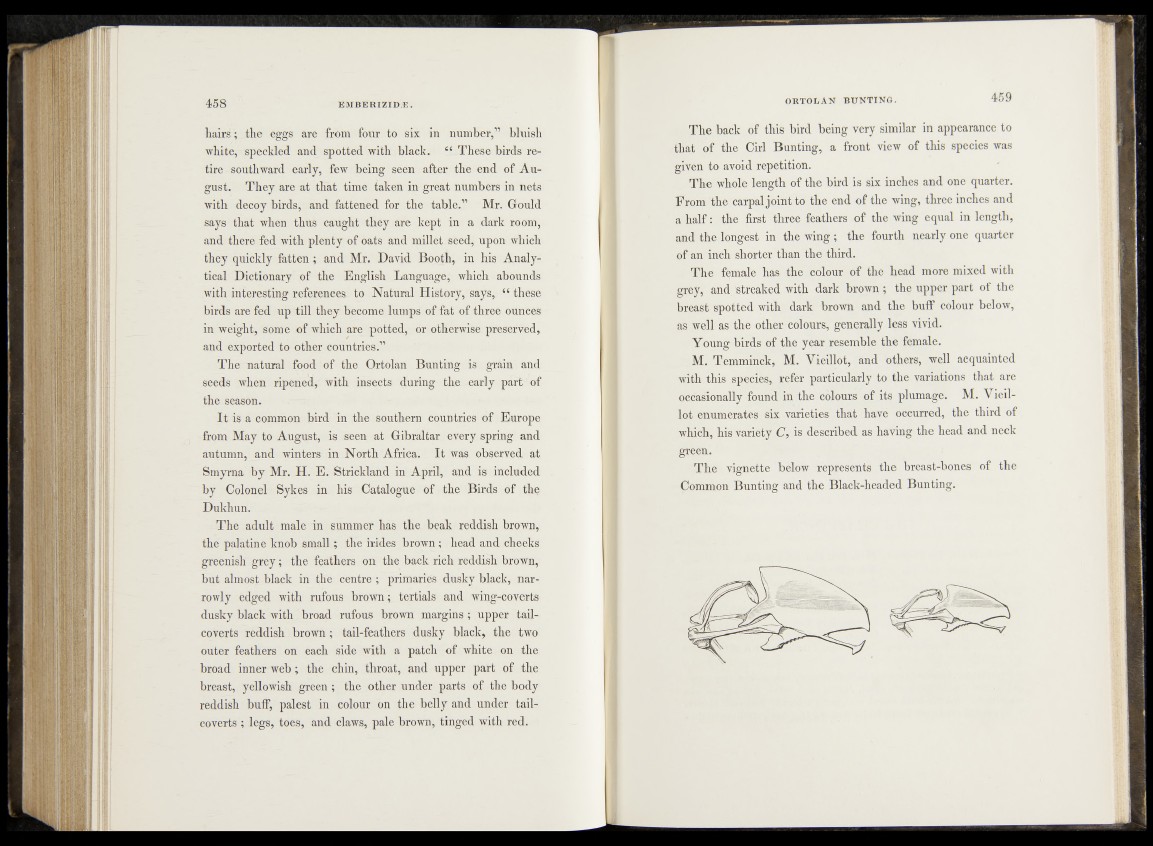
hairs; the eggs are from four to six in number,” bluish
white, speckled and spotted with black. “ These birds retire
southward early, few being seen after the end of August.
They are at that time taken in great numbers in nets
with decoy birds, and fattened for the table.” Mr. Gould
says that when thus caught they are kept in a dark room,
and there fed with plenty of oats and millet seed, upon which
they quickly fatten ; and Mr. David Booth, in his Analytical
Dictionary of the English Language, which abounds
with interesting references to Natural History, says, “ these
birds are fed up till they become lumps of fat of three ounces
in weight, some of which are potted, or otherwise preserved,
and exported to other countries.”
The natural food of the Ortolan Bunting is grain and
seeds when ripened, with insects during the early part of
the season.
I t is a common bird in the southern countries of Europe
from May to August, is seen at Gibraltar every spring and
autumn, and winters in North Africa. I t was observed at
Smyrna by Mr. H. E. Strickland in April, and is included
by Colonel Sykes in his Catalogue of the Birds of the
Dukhun.
The adult male in summer has the beak reddish brown,
the palatine knob small; the irides brown J head and cheeks
greenish grey; the feathers on the back rich reddish brown,
but almost black in the centre ; primaries dusky black, narrowly
edged with rufous brown; tertials and wing-coverts
dusky black with broad rufous brown margins ; upper tail-
coverts reddish brown ; tail-feathers dusky black, the two
outer feathers on each side with a patch of white on the
broad inner web ; the chin, throat, and upper part of the
breast, yellowish green ; the other under parts of the body
reddish buff, palest in colour on the belly and under tail-
coverts ; legs, toes, and claws, pale brown, tinged with red.
The back of this bird being very similar in appearance to
that of the Cirl Bunting, a front view of this species was
given to avoid repetition.
The whole length of the bird is six inches and one quarter.
From the carpal joint to the end of the wing, three in ches and
a half: the first three feathers of the wing equal in length,
and the longest in the wing ; the fourth nearly one quarter
of an inch shorter than the third.
The female has the colour of the head more mixed with
grey, and streaked with dark brown ; the upper part of the
breast spotted with dark brown and the butf colour below,
as well as the other colours, generally less vivid.
Young birds of the year resemble the female.
M. Temminck, M. Vieillot, and others, well acquainted
with this species, refer particularly to the variations that are
occasionally found in the colours of its plumage. M. Vieillot
enumerates six varieties that have occurred, the third of
which, his variety C, is described as having the head and neck
green.
The vignette below represents the breast-bones of the
Common Bunting and the Black-headed Bunting.